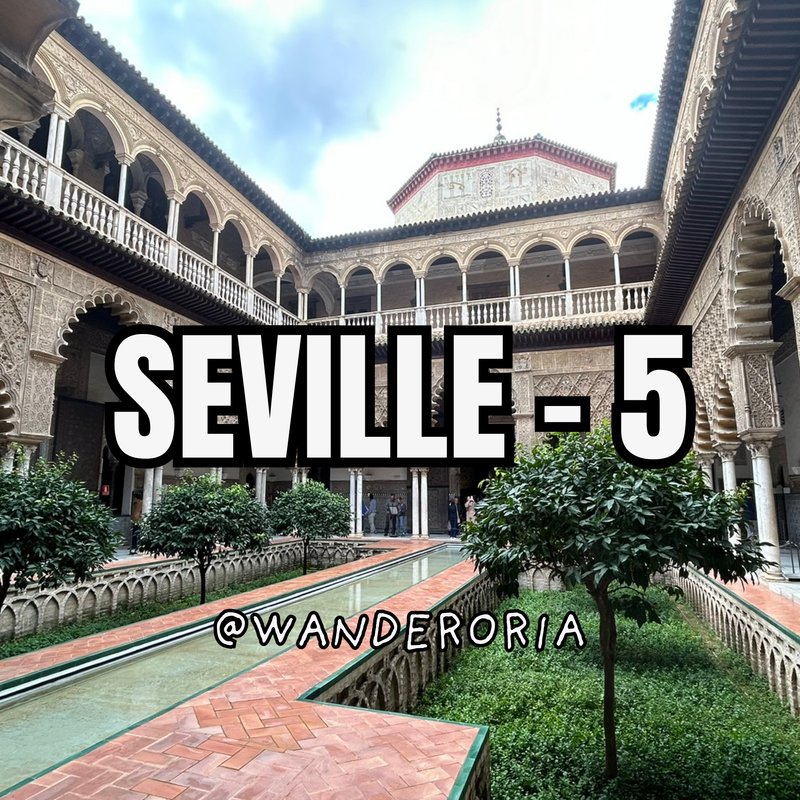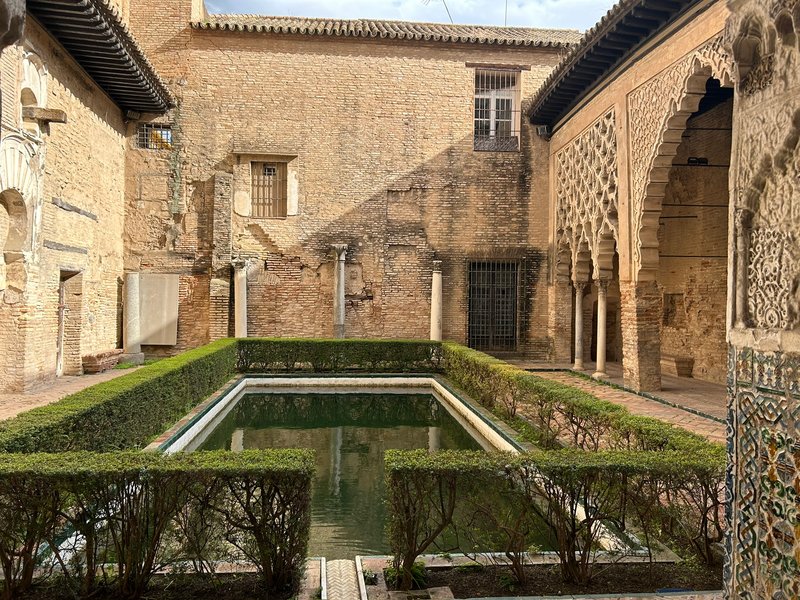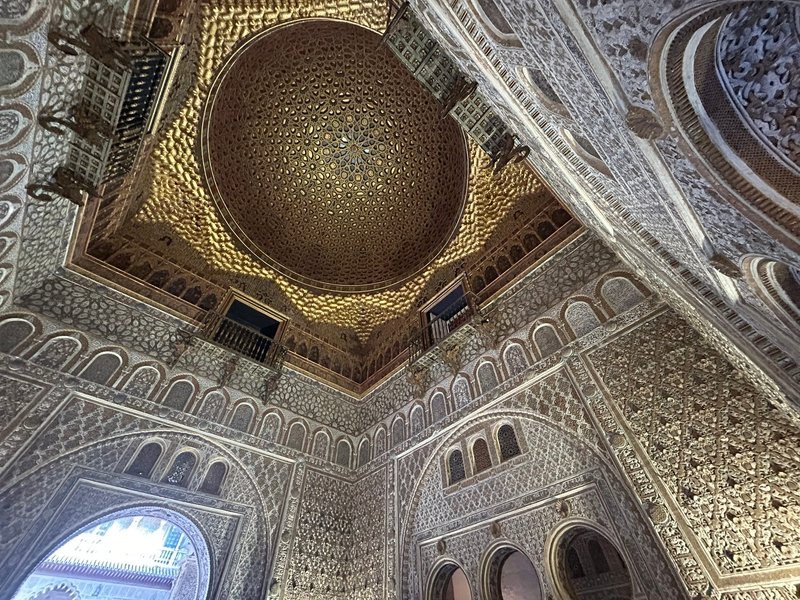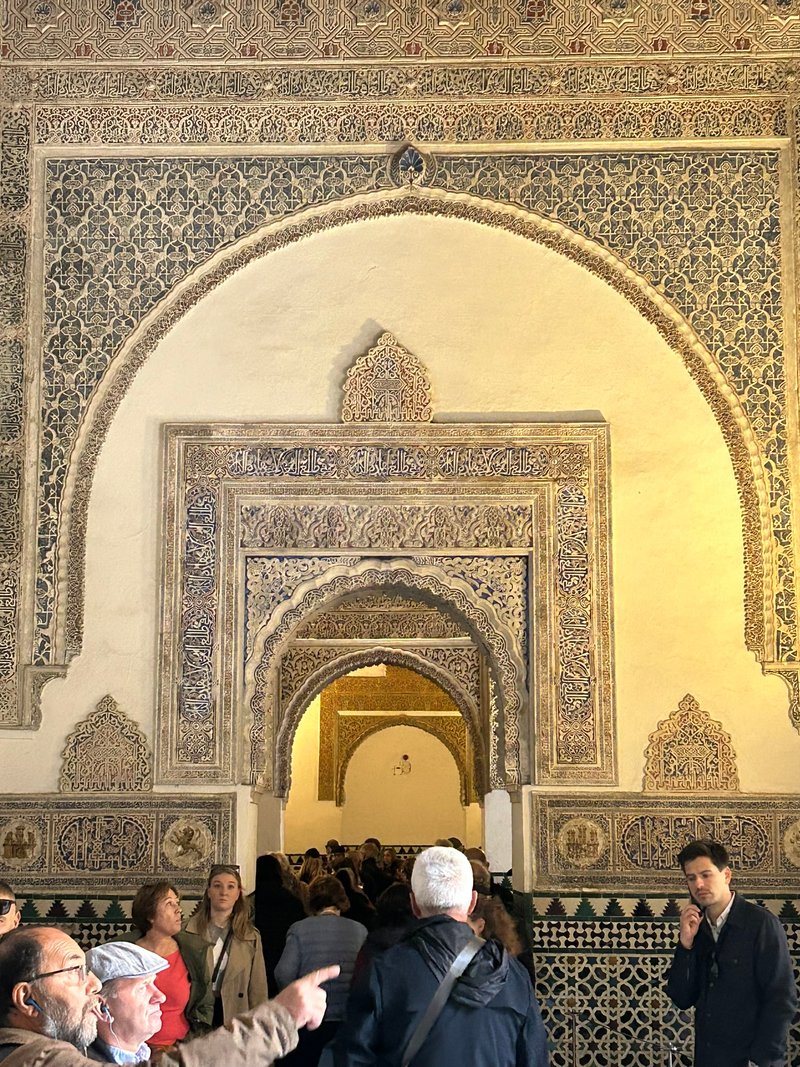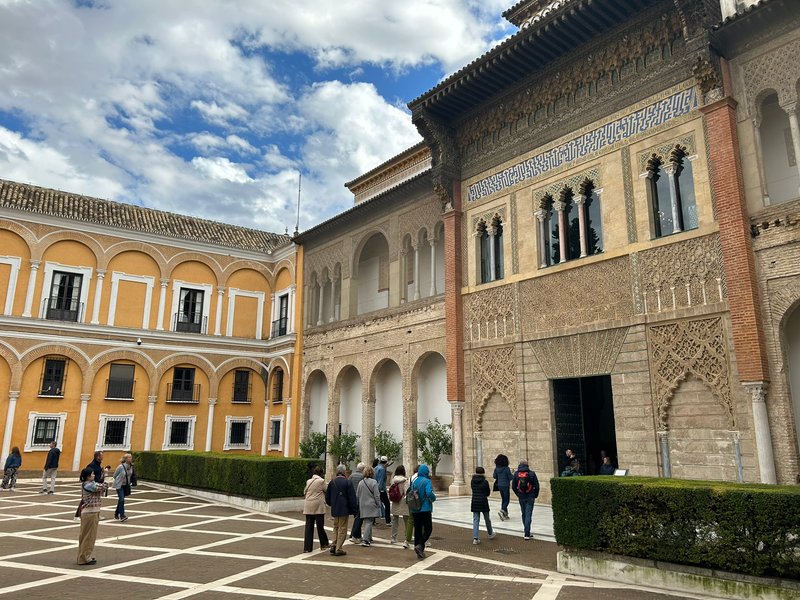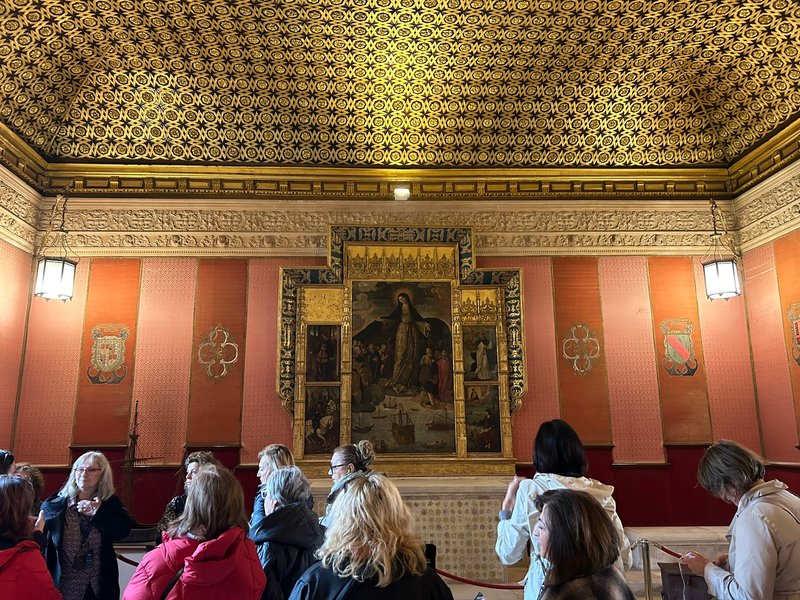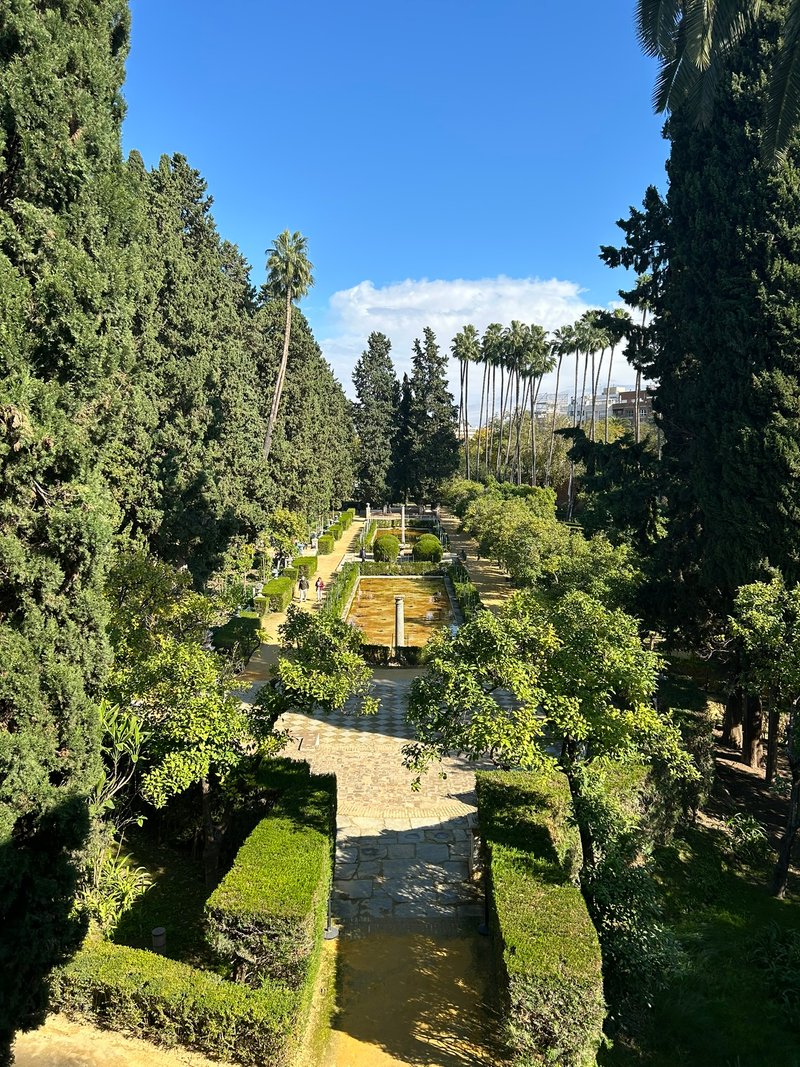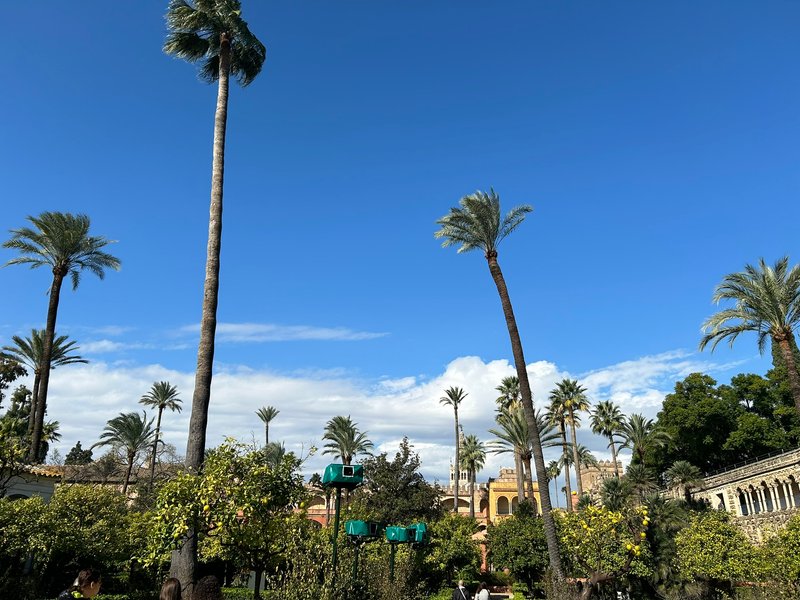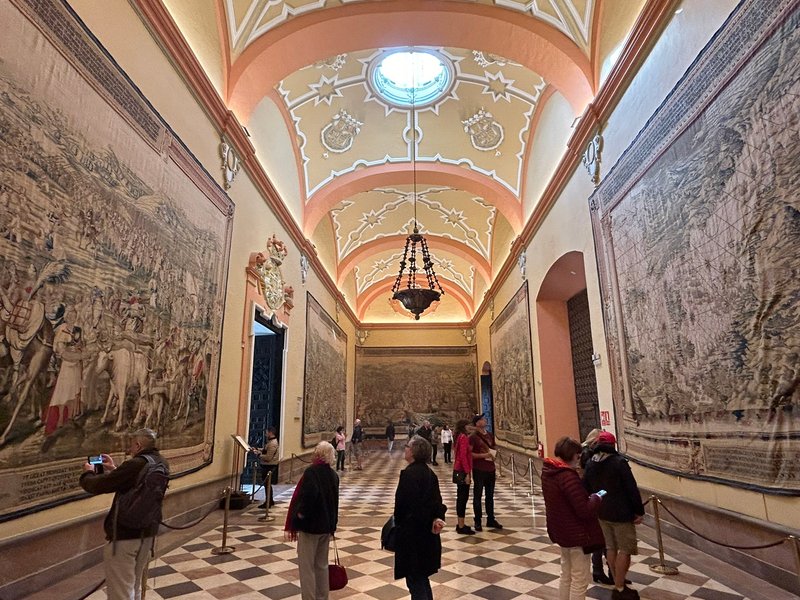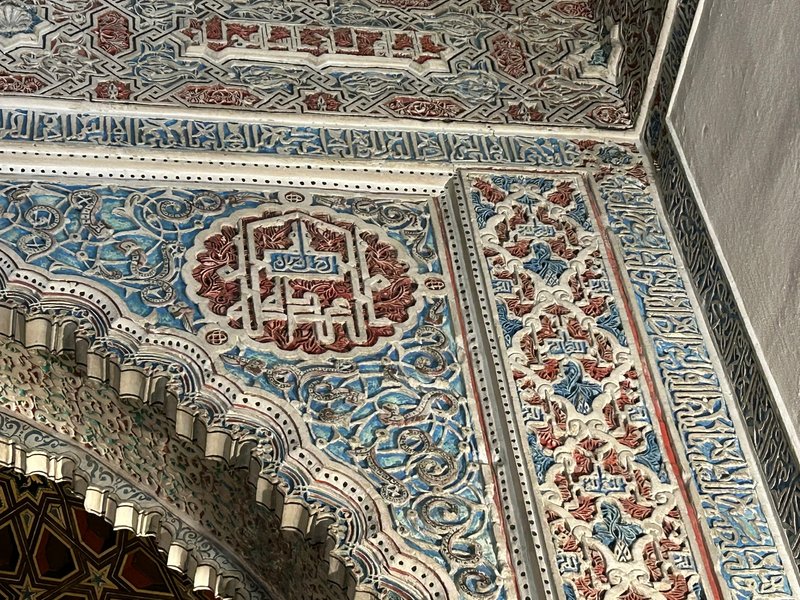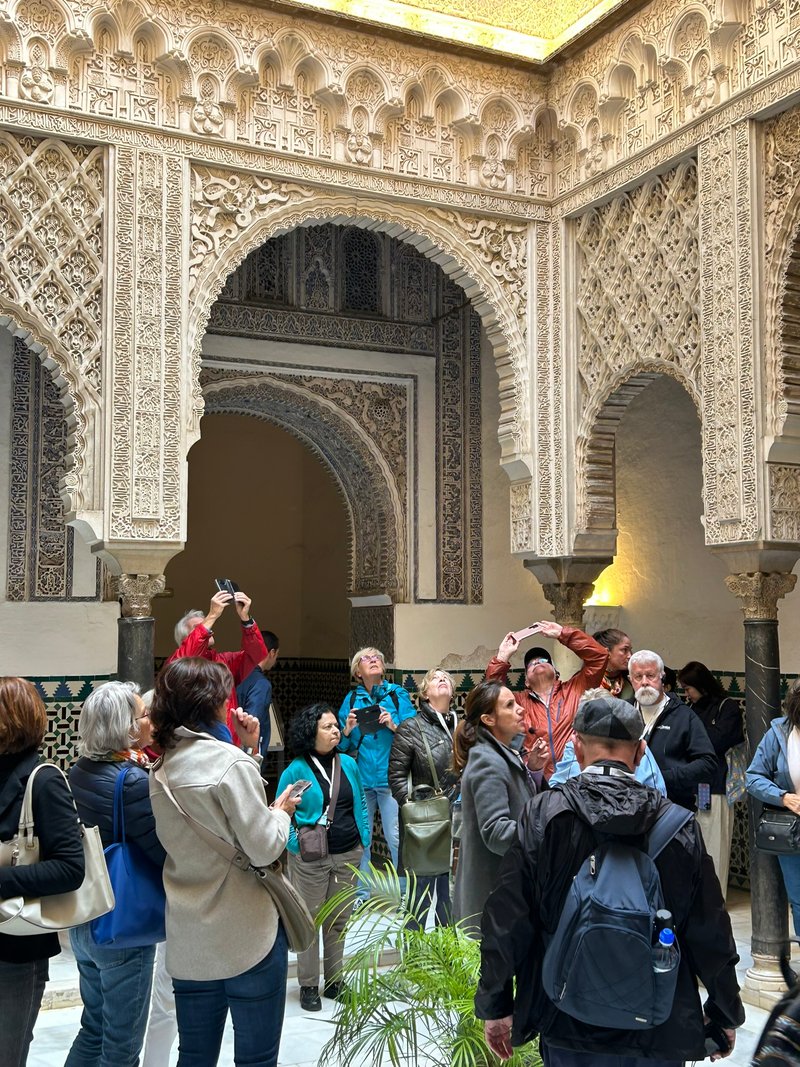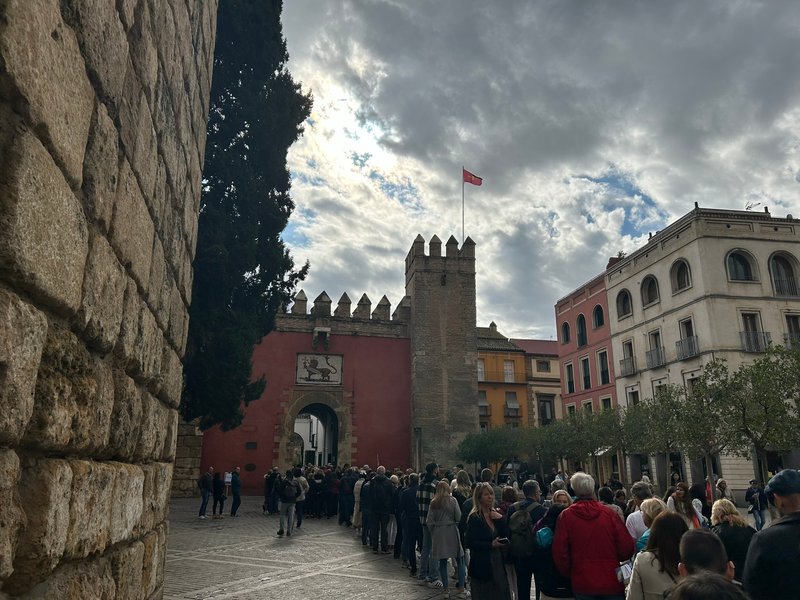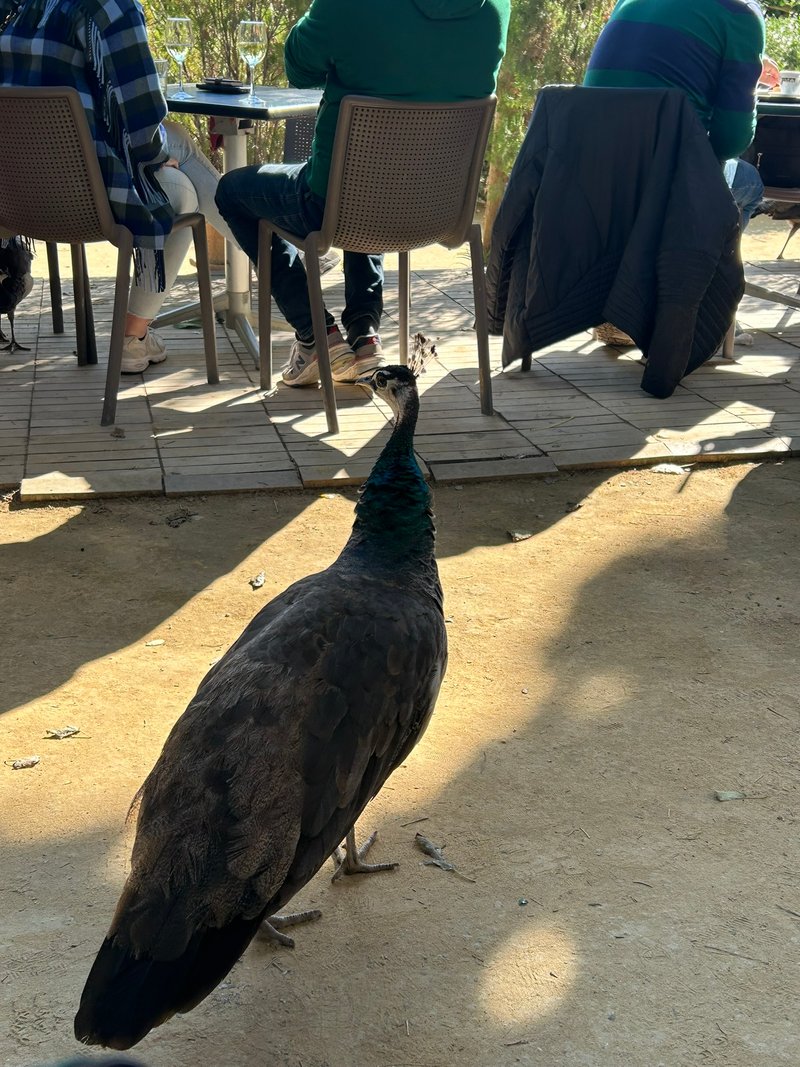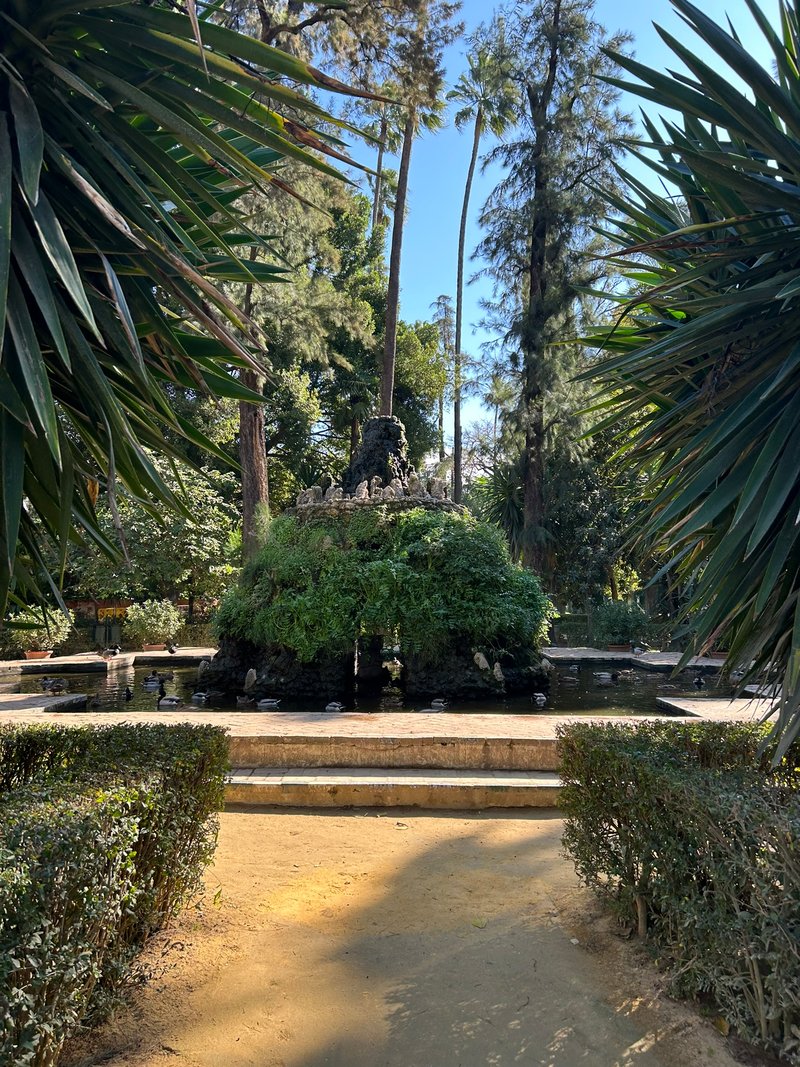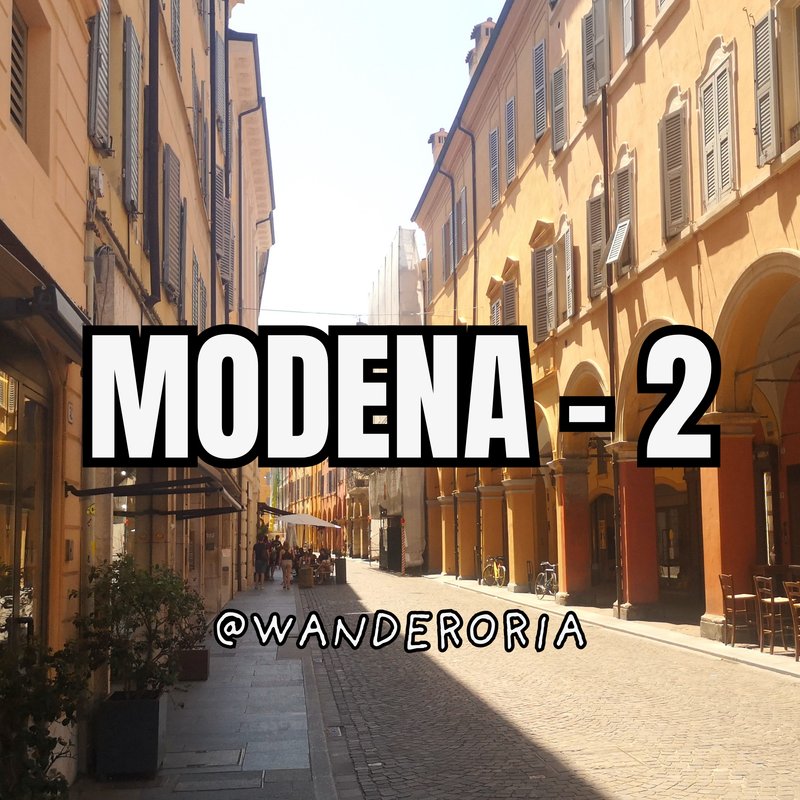A Royal Palace in the Heart of Seville - Real Alcázar
- Introduction
- History – From the 10th Century to the Present
- The Muslim Period (10th–12th Century)
- The Christian Reconquest (13th–15th Century)
- Renaissance and Beyond (16th–18th Century)
- Modern Times (19th Century–Today)
- Mudejar Architecture – The Fusion of Islamic Art and Royal Power
- Tiles & Arches
- Exquisite Woodwork
- Why Mudejar Matters in the Alcázar
- Royal Halls – The Heart of the Palace’s Splendor
- Hall of Ambassadors (Salón de Embajadores)
- Patio de las Doncellas (Courtyard of the Maidens)
- Why the Royal Halls Are Significant
- Gardens – A Paradise of Orange Trees and Hidden Paths
- Orange Trees and Fragrance Everywhere
- Labyrinthine Paths and Secret Corners
- Water as the Soul of the Gardens
- Why the Gardens Matter
- The Gothic Section – Renaissance Touches and the Magic of Water
- Gothic Architecture in the Alcázar
- Renaissance Additions
- The Underground Pools – Baths of Doña María de Padilla
- Why the Gothic Section Matters
- Film & TV Productions – The Alcázar on the Big Screen
- Game of Thrones – The Water Gardens of Dorne
- Other Famous Productions
- Why Filmmakers Choose the Alcázar
- A Bonus for Visitors
- Visitor Information – How to Plan Your Visit to the Real Alcázar
- Tickets – Book Online to Skip the Lines
- Opening Hours
- How Much Time Do You Need?
- Guided Tours & Audio Guides
- Practical Tips
- Hidden Corners – Secret Courtyards and Quiet Gardens
- The Charm of Small Courtyards
- Quiet Gardens
- Lesser-Known Passages and Views
- Why These Spaces Matter
- Conclusion – Feeling the Soul of the Alcázar
-
Introduction – A Royal Palace in the Heart of Seville
When visiting Seville, few places capture the city’s soul as powerfully as the Real Alcázar of Seville. Located right in the historic center, next to the Seville Cathedral and Archivo de Indias, this royal palace complex is not only an architectural masterpiece but also a living symbol of Andalusian history.
Recognized as a UNESCO World Heritage Site, the Real Alcázar holds the title of being the oldest royal palace in Europe still in use. To this day, the Spanish royal family resides in its upper chambers during official visits to Seville, making it a unique blend of history and living tradition.
Stepping inside the Alcázar feels like embarking on a journey through 1,000 years of history. From the Islamic legacy of the Umayyads to the Christian reconquest, from Gothic and Renaissance influences to Baroque and Mudejar artistry, every corner of the palace reflects a new layer of Seville’s past. Stunning tiled arches, intricate wooden ceilings, majestic courtyards, and orange-scented gardens create an atmosphere that enchants every visitor.
But the Alcázar is not only about architecture—it is also about stories and legends. Royal weddings, diplomatic receptions, artistic inspiration, and even popular films and TV shows have left their mark on these walls.
With its rich history, breathtaking artistry, and serene gardens, the Real Alcázar is more than just a palace; it is the heart of Seville’s identity. To truly understand the city, you must begin your journey here.
-
History – From the 10th Century to the Present
The Royal Alcázar of Seville is one of the most fascinating monuments in Spain, with a history that stretches back over 1,000 years. Over the centuries, it has served as a residence for Muslim emirs, Christian kings, and even today remains a symbol of royal power and cultural fusion.
The Muslim Period (10th–12th Century)
The origins of the Alcázar date to 913 AD, when Abd al-Rahman III of the Umayyad dynasty ordered the construction of a fortified palace known as Al-Muwarak. Later, in the 11th century, under the Abbadid dynasty, the complex was expanded and transformed into a luxurious residence. The celebrated ruler Al-Mu’tamid adorned the palace with elegant gardens, fountains, and intricate courtyards, turning it into a jewel of Islamic architecture in Al-Andalus.
The Christian Reconquest (13th–15th Century)
In 1248, Seville was conquered by Ferdinand III of Castile. Instead of destroying the Muslim palaces, the Christian kings preserved and expanded them, blending Islamic craftsmanship with their own styles.
The most influential transformation came under King Peter I (Pedro the Cruel) in the 14th century. He commissioned Muslim artisans to construct new halls and courtyards in the Mudejar style, merging Islamic artistry with Christian symbolism. As a result, the Alcázar became one of the most remarkable examples of cultural coexistence in Europe.
Renaissance and Beyond (16th–18th Century)
During Spain’s Golden Age, the Alcázar continued to evolve. Charles V (Holy Roman Emperor) added Renaissance elements, commissioning new wings and celebrating his marriage at the palace. Gothic halls, Renaissance courtyards, and Baroque details were added over time, creating a fascinating blend of styles.
The Alcázar was not just a residence—it was also a stage for royal weddings, state banquets, and political negotiations, making it a true center of power.
Modern Times (19th Century–Today)
In the 19th century, the Alcázar became the official royal residence in Seville, a role it still maintains. When King Felipe VI and the Spanish royal family visit Seville, they stay in the upper chambers of the palace. This makes the Real Alcázar the oldest royal palace in Europe still in use.
Today, millions of visitors from all over the world come to explore its halls, courtyards, and gardens. The Alcázar’s layered history—Muslim artistry, Christian power, Renaissance elegance—makes it a living testament to the cultural richness of Andalusia.
-
Mudejar Architecture – The Fusion of Islamic Art and Royal Power
One of the features that makes the Real Alcázar of Seville truly unique is its breathtaking Mudejar architecture. After the Christian conquest, Muslim artisans—known as Mudejares—continued to work under Christian rule, blending their centuries-old Islamic artistic traditions with Gothic and Renaissance elements. The result was a one-of-a-kind architectural style that defines much of the Alcázar’s character today.
Tiles & Arches
As you walk through the palace, the first thing that captivates your eyes is the dazzling azulejo tiles. These hand-painted ceramic tiles, with their geometric and floral designs, are a hallmark of Andalusian art. The walls of the Patio de las Doncellas (Courtyard of the Maidens) in particular showcase some of the most striking tilework, creating a mesmerizing harmony of color and pattern.
Equally iconic are the arches—horseshoe-shaped, multi-layered, and intricately decorated. These arches embody the essence of Mudejar art, combining Islamic geometry with Christian grandeur.
Exquisite Woodwork
Perhaps the most impressive expression of Mudejar craftsmanship can be found in the wooden ceilings. Known as artesonados, these carved and painted ceilings feature complex star patterns and geometric motifs.
The highlight is without a doubt the dome of the Hall of Ambassadors (Salon de Embajadores). Its golden star-shaped ceiling, built in the 14th century, is a masterpiece of engineering and artistry. The design symbolizes the heavens, reminding visitors of the spiritual and cosmic dimension of Islamic art, while serving as a backdrop for royal receptions.
Why Mudejar Matters in the Alcázar
The Mudejar style in the Real Alcázar is not just about aesthetics—it is a symbol of cultural coexistence. It represents how different religions and traditions, despite centuries of conflict, managed to create something timeless and beautiful together.
For today’s visitors, the Mudejar halls and courtyards are a chance to step into the Golden Age of Al-Andalus, where Islamic art and Christian royalty merged into one of the most enchanting architectural legacies in Europe.
-
Royal Halls – The Heart of the Palace’s Splendor
The Royal Alcázar of Seville is full of architectural wonders, but its royal halls are where history, politics, and artistry truly converge. For centuries, these halls hosted royal weddings, diplomatic meetings, and grand ceremonies, serving as the beating heart of the palace. Among the many chambers, two stand out as the most iconic: the Hall of Ambassadors and the Patio de las Doncellas.
Hall of Ambassadors (Salón de Embajadores)
Often regarded as the crown jewel of the Alcázar, the Hall of Ambassadors was commissioned by King Peter I (Pedro the Cruel) in the 14th century. This hall was used to receive foreign dignitaries and ambassadors, making it a stage for some of the most important political moments in Spanish history.
The centerpiece of the hall is its stunning golden dome ceiling, a masterpiece of Mudejar woodwork. Designed in the form of a starry sky, it symbolizes the universe and the eternal power of the monarchy. Gilded with intricate geometric details, it reflects the incredible skill of Muslim artisans who worked under Christian patronage.
Surrounding the dome are multi-arched balconies from which nobles and members of the royal family could watch the ceremonies below. The walls, adorned with colorful tiles and Arabic inscriptions, remind visitors of the palace’s Islamic heritage, even in a room used for Christian rulers’ diplomacy.
Patio de las Doncellas (Courtyard of the Maidens)
Perhaps the most photographed spot in the Alcázar, the Patio de las Doncellas is a breathtaking example of Mudejar elegance. At its center lies a long reflecting pool flanked by orange trees, surrounded by exquisite arches and galleries decorated with lace-like stucco.
Its name, the “Courtyard of the Maidens,” is tied to a legend claiming that Christian kingdoms once had to pay tribute to the Muslim rulers by sending one hundred maidens every year. While historians agree this is a myth, the story adds an air of mystery to the courtyard.
During the 20th century, excavations revealed the original sunken gardens around the pool, restoring the courtyard to its 14th-century glory. Today, it is one of the most enchanting places in the Alcázar, where light, water, and architecture merge to create a dreamlike atmosphere.
Why the Royal Halls Are Significant
These two spaces—the Hall of Ambassadors and the Patio de las Doncellas—represent the essence of the Alcázar: power, beauty, and cultural blending. Stepping into them feels like entering the very stage where Spain’s history was written.
Whether you are captivated by the golden dome, the elegant arches, or the peaceful reflection pool, the royal halls are guaranteed to be among the highlights of your visit.
-
Gardens – A Paradise of Orange Trees and Hidden Paths
The Gardens of the Real Alcázar of Seville are as enchanting as the palace itself. Covering more than seven hectares, these gardens are a perfect blend of Islamic, Renaissance, and Baroque landscaping traditions. With their fragrant orange trees, labyrinth-like paths, and soothing fountains, they offer visitors a serene escape from the bustling city.
Orange Trees and Fragrance Everywhere
One of the most iconic sights of the Alcázar gardens is the abundance of orange trees. These trees are not just decorative; they embody the spirit of Seville, a city long associated with citrus blossoms. In spring, the gardens are filled with the sweet aroma of orange flowers, creating an unforgettable sensory experience.
Strolling under their shade, you’ll find elegant fountains, marble statues, and tiled benches that invite you to sit and absorb the timeless beauty of Andalusian garden design.
Labyrinthine Paths and Secret Corners
The Alcázar gardens are not a single open space but rather a series of interconnected areas, each with its own character. The Labyrinth Garden (Jardín del Laberinto) is one of the highlights, offering a playful challenge to visitors of all ages. Following its winding paths feels like stepping into a living maze of history and nature.
Other hidden corners, like the Garden of the Dance (Jardín de la Danza), reveal more intimate spaces where you can enjoy moments of tranquility surrounded by greenery and delicate architecture.
Water as the Soul of the Gardens
Water plays a central role in Andalusian garden design, and the Alcázar is no exception. Gentle streams, decorative ponds, and trickling fountains create a refreshing atmosphere, especially during Seville’s hot summers when temperatures often soar above 40°C.
The sound of running water, combined with the scent of citrus blossoms and the shade of ancient trees, transforms the gardens into a true oasis of peace.
Why the Gardens Matter
For centuries, the gardens of the Real Alcázar have been used for leisure, meditation, and royal entertainment. Muslim rulers designed them as earthly representations of paradise, while Christian monarchs later added Renaissance touches and Baroque features. Today, they stand as a living testament to Seville’s layered history.
Visiting the gardens is more than just a walk—it’s an immersion into Andalusia’s unique blend of nature, art, and culture. Take your time, sit by a fountain, and let the serenity of this timeless paradise become one of your most cherished memories of Seville.
-
The Gothic Section – Renaissance Touches and the Magic of Water
While the Real Alcázar of Seville is best known for its dazzling Mudejar architecture, its Gothic section reveals an entirely different side of the palace. Built after the Christian conquest of Seville in the 13th century, this area reflects the influence of European medieval architecture. With its imposing stone walls, high vaulted ceilings, and mystical underground chambers, the Gothic halls stand in sharp contrast to the ornate Islamic designs found elsewhere in the palace.
Gothic Architecture in the Alcázar
Commissioned by the Christian monarchs, the Gothic section showcases soaring arches, solid stone construction, and monumental spaces. The Gothic Halls (Salones Góticos) were primarily used for grand banquets and official state events, serving as a powerful display of Christian authority after the Reconquista.
Unlike the colorful tiles and delicate stucco of the Mudejar areas, the Gothic halls emphasize strength and grandeur. Their austere elegance creates a striking balance with the rest of the palace, highlighting the Alcázar’s multi-layered history.
Renaissance Additions
Over time, Renaissance influences were added to soften and enrich the Gothic design. Decorative details, frescos, and subtle Italian-inspired elements brought a touch of humanism to these medieval halls. This blending of styles makes the Gothic section an architectural bridge between two very different eras.
The Underground Pools – Baths of Doña María de Padilla
One of the most fascinating parts of the Gothic section is the Baths of Doña María de Padilla (Baños de Doña María de Padilla). These are vast underground rainwater tanks, named after María de Padilla, the beloved mistress of King Peter I.
Legend has it that María herself used these vaulted chambers to bathe, adding a romantic and mysterious aura to the space. Today, visitors are captivated by the reflections of the pointed arches in the still water, creating one of the most atmospheric and photogenic spots in the Alcázar.
Why the Gothic Section Matters
The Gothic section is essential to understanding the layers of history within the Real Alcázar. While the Mudejar and Renaissance areas celebrate cultural fusion, the Gothic halls represent the assertion of Christian rule and medieval European power.
Together, these spaces transform the Alcázar into a living history book, where each chapter of Andalusia’s past is written in stone, wood, and water. For visitors, the Gothic section offers not just architectural beauty but also a profound sense of how Seville evolved through centuries of change.
-
Film & TV Productions – The Alcázar on the Big Screen
The Real Alcázar of Seville is not only a jewel of Andalusian history and architecture but also a favorite filming location for directors around the world. With its exotic gardens, ornate courtyards, and majestic halls, the palace has served as a natural movie set for some of the most iconic productions in cinema and television.
Game of Thrones – The Water Gardens of Dorne
The Alcázar became world-famous when it appeared in HBO’s hit series Game of Thrones. In seasons five and six, the palace represented the Water Gardens of Dorne, the home of House Martell.
Scenes filmed in the Patio de las Doncellas and the lush royal gardens brought millions of viewers face-to-face with the Alcázar’s breathtaking beauty. For many fans, visiting Seville became a must-do pilgrimage, significantly boosting tourism to the palace.
Other Famous Productions
Beyond Game of Thrones, the Real Alcázar has appeared in numerous international films and series, including:
- 🎥 Lawrence of Arabia (1962) – The Oscar-winning epic used parts of the Alcázar to recreate Middle Eastern palaces.
- 🎥 Kingdom of Heaven (2005) – Directed by Ridley Scott, this historical film about the Crusades included scenes shot inside the Alcázar’s Gothic halls.
- 🎥 Knight and Day (2010) – Starring Tom Cruise and Cameron Diaz, the film features short sequences in the palace gardens.
The Alcázar is also frequently featured in Spanish films, documentaries, and cultural programs thanks to its timeless atmosphere.
Why Filmmakers Choose the Alcázar
What makes the Alcázar so attractive to filmmakers is its authentic historic atmosphere. Its Mudejar arches, Gothic halls, and exotic gardens provide ready-made backdrops that would be impossible to replicate in a studio. The palace allows directors to transport viewers into different times and places without building elaborate sets.
A Bonus for Visitors
Today, many tourists walk through the Alcázar’s courtyards and gardens with a sense of déjà vu, recognizing scenes from their favorite movies and shows. For Game of Thrones fans, retracing the footsteps of Prince Doran Martell or the Sand Snakes adds an exciting layer to the visit.
-
Visitor Information – How to Plan Your Visit to the Real Alcázar
A trip to Seville wouldn’t be complete without exploring the Real Alcázar, but because it is one of the city’s most popular attractions, proper planning is essential. To make the most of your visit, here’s everything you need to know before stepping through its gates.
Tickets – Book Online to Skip the Lines
The Alcázar attracts millions of visitors each year, which means long queues, especially in spring and summer. The best way to save time is to buy your tickets online in advance.
- 🎟 General admission: €13.50 (2025 price update)
- 🎟 Reduced ticket (students & pensioners): €6
- 🎟 Children under 12 & visitors with disabilities: Free
- 🎟 Royal Apartments (Cuarto Real Alto): Additional €5.50
Opening Hours
The Alcázar is open year-round (except on January 1, January 6, and December 25):
- October 1 – March 31: 09:30 – 17:00
- April 1 – September 30: 09:30 – 19:00
⏰ Best time to visit: Early in the morning (09:30–11:00) when crowds are smaller, or late afternoon for a quieter atmosphere in the gardens.
How Much Time Do You Need?
The palace complex is vast. A quick visit may take about 1.5–2 hours, but to fully appreciate the royal halls, Mudejar courtyards, and gardens, you should dedicate at least 3–4 hours. If you enjoy photography, consider setting aside half a day.
Guided Tours & Audio Guides
- 📱 Audio guides are available at the entrance or via mobile apps.
- 👩🏫 For a deeper experience, you can join guided tours that explain the history and legends of the Alcázar. Popular options include Game of Thrones-themed tours that highlight filming locations.
Practical Tips
- Bring water, especially in summer—temperatures in Seville can exceed 40°C.
- Wear comfortable shoes; the palace grounds and gardens involve a lot of walking.
- Photography is allowed, but flash is prohibited in the Royal Apartments.
- There is a small café inside, but options are limited. Many visitors prefer to enjoy tapas in the surrounding Santa Cruz neighborhood after their visit.
-
Hidden Corners – Secret Courtyards and Quiet Gardens
While the grand halls and famous courtyards of the Real Alcázar of Seville are breathtaking, some of its most magical experiences lie in the hidden corners that many visitors overlook. These quieter spaces reveal the more intimate side of the palace, offering moments of peace away from the crowds.
The Charm of Small Courtyards
Beyond the iconic Patio de las Doncellas and the majestic Hall of Ambassadors, narrow passageways lead to smaller, less-visited courtyards. These spaces, with their elegant arches and modest decorations, capture the palace’s original essence.
One of the most notable examples is the Patio del Yeso, dating back to the earliest Islamic period of the Alcázar. With its understated beauty and simple stucco work, it feels like a time capsule, transporting visitors back to the 12th century.
Quiet Gardens
The Alcázar’s main gardens are vast and impressive, but tucked away are smaller, serene gardens designed for reflection and relaxation. The Garden of the Dance (Jardín de la Danza), with its water channels and symmetrical layout, creates a soothing environment where the only sounds are birdsong and trickling water.
Another hidden gem is the Garden of Troy (Jardín de Troya), a labyrinth-like space that adds a playful element to the palace grounds. Exploring its paths is particularly fun for families with children.
Lesser-Known Passages and Views
In addition to courtyards and gardens, the Alcázar hides a network of small staircases, balconies, and shaded corridors. These areas often provide unique vantage points over the main courtyards or glimpses of the palace’s layered architecture. The underground galleries in the Gothic section are especially fascinating, offering a cool, mysterious escape during hot summer days.
Why These Spaces Matter
These hidden corners are what make the Alcázar feel truly alive. They allow visitors to experience the palace beyond its grandeur—to discover its soul of quiet beauty. While the great halls symbolize royal power, the secret courtyards and secluded gardens whisper stories of everyday life, intimacy, and contemplation.
Exploring these lesser-known spots ensures that your visit is not just about the highlights, but also about the personal, unforgettable moments that make the Real Alcázar so special.
-
Conclusion – Feeling the Soul of the Alcázar
The Real Alcázar of Seville is far more than just a palace. It is a living chronicle of Andalusia’s history, where Islamic artistry, Christian power, Renaissance elegance, and Baroque details coexist in harmony. From its 10th-century Muslim origins to its present-day role as a royal residence, the Alcázar embodies the essence of Seville itself.
Walking through its gates is not merely a sightseeing experience—it is an immersion into a 1,000-year-old cultural mosaic. The golden dome of the Hall of Ambassadors, the serene pool of the Patio de las Doncellas, the scent of orange blossoms in the gardens, and the quiet charm of hidden courtyards all combine to tell the story of a city shaped by many civilizations.
For travelers, the Alcázar is both an introduction and a farewell to Seville. It invites you to start your journey here, where history comes alive in every tile, every arch, and every drop of water in the fountains. Whether you are a history enthusiast, an architecture lover, a photographer, or simply someone seeking beauty, the Alcázar will leave you with unforgettable memories.
If you are planning your trip, make sure to dedicate enough time—at least half a day—to truly explore both the majestic halls and the tranquil gardens. Sit beneath the orange trees, listen to the fountains, and let the atmosphere sink in. That moment will stay with you long after you leave Seville.
The Real Alcázar is not just a must-see attraction—it is the soul of Seville, waiting to be discovered.
